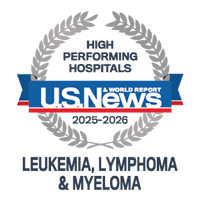Lymphoma

Overview
What is lymphoma?
Lymphoma is a type of blood cancer that develops in cells of the lymphatic system. Part of immune function, the lymphatic system plays an important role in your body’s response to disease and infection.
There are many kinds of lymphoma, but the two main ones are Hodgkin’s and non-Hodgkin’s. Identifying the type helps us determine which treatment options may work best. Treatments for lymphoma include chemotherapy, immunotherapy, radiation therapy, stem cell or bone marrow transplant (BMT), and various combinations of these therapies.
Our approach to lymphoma
UCSF delivers state-of-the-art treatment for lymphoma with care and compassion. We offer the full range of options for newly diagnosed patients as well as for those whose lymphoma has recurred.
We are also dedicated to research on better approaches to treating lymphoma and other cancers. Interested patients may have opportunities to participate in clinical trials of promising new therapies.
Risk factors for lymphoma
Like any cancer, certain environmental or personal health factors can contribute to the development of lymphoma. These factors include:
- Age. The risk of lymphoma increases as you get older, with most cases diagnosed in people over 60. However, some types of lymphoma are more common in younger people.
- Sex. In general, lymphomas tend to be more common in males. However, certain forms of non-Hodgkin's lymphoma are more common in females.
- Family history. The risk of lymphoma is slightly higher if a close family member (parent, sibling or child) has had it. However, most people who get lymphoma have no family history of the disease.
- Medications. Patients who take drugs that suppress the immune system (commonly prescribed after an organ transplant) have an increased risk of non-Hodgkin's lymphoma.
- Exposure to toxins. Having been exposed to excessive radiation or certain chemicals may increase the risk of developing non-Hodgkin's lymphoma.
- Viruses. Patients with viral infections or viral conditions that depress the immune system (such as the Epstein-Barr virus, HIV or AIDS) are more prone to lymphoma.
It's important to understand that having one or more of these risk factors doesn't mean you'll get lymphoma. Many people with one or more risk factors never have lymphoma, and some with no known risk factors do develop the disease.
Types of lymphoma
While there are many types of lymphoma, Hodgkin's and non-Hodgkin's lymphoma are the two main ones.
Both conditions develop in lymphocytes, a kind of white blood cell that's part of the immune system. There are two main types of lymphocytes:
- B cells (B lymphocytes). B cells produce antibodies that fight bacteria and viruses.
- T cells (T lymphocytes). Different types of T cells have different jobs: Some destroy germs and abnormal cells; some send signals that direct other immune cells to fight infection.
Lymphoma can start in either type of lymphocyte but is more commonly associated with B cells.
Symptoms of lymphoma
Non-Hodgkin's lymphoma and Hodgkin's lymphoma can have similar symptoms. They may include:
- A painless swelling in lymph nodes of the neck, armpit or groin
- Unexplained recurrent fevers
- Night sweats
- Unexplained weight loss
- Itchy skin
Having these symptoms doesn't mean you have lymphoma. Other, less serious conditions – such as the flu – can cause such symptoms. However, if your symptoms persist, you should see your doctor. A diagnosis of lymphoma can be made only through medical testing.
Diagnosis of lymphoma
If your doctor thinks you could have lymphoma, they'll ask about your medical history and perform a physical exam. The exam may include feeling lymph nodes in the neck, armpit and groin as well as feeling to see whether your liver or spleen is enlarged. Your doctor will also check certain signs of general health and may order blood tests.
Other tests used to confirm the diagnosis may include:
- X-Rays. A chest X-ray can show enlarged lymph nodes or other changes possibly associated with cancer.
- Computed tomography (CT) scan. A thin X-Ray beam rotates around the affected area to construct a three-dimensional, cross-sectional image.
- Magnetic resonance imaging (MRI). This scan uses a powerful magnet linked to a computer to create detailed pictures of areas inside the body.
- PET scan. For this test, a small amount of radioactive glucose (sugar) is injected into a vein and the PET scanner creates images showing where the glucose is used. Cancer cells show up brighter because they are more active and take up more glucose than normal cells do.
- Biopsy. A lymphoma diagnosis also depends on a biopsy, in which a surgeon removes a tissue sample to be examined in the lab for cancer cells. For lymphoma, the biopsy is usually taken from a lymph node, though other tissues may be sampled as well.
- Laparotomy. This describes a procedure that cuts into the abdomen. When lymphoma is suspected, a laparotomy may be performed to remove samples of lymph tissue, which are then checked under a microscope.
Treatment of lymphoma
How we treat lymphoma depends on the type and stage, the size of lymph nodes, your symptoms, your age, your overall health and other factors.
Radiation therapy and chemotherapy are the most common treatments. Bone marrow transplantation (BMT), peripheral stem cell transplantation and biological therapies may also be treatment options, sometimes through clinical trials.
Radiation therapy for lymphoma
Radiation therapy, also called radiotherapy, uses high-energy rays to kill cancer cells. Depending on the cancer's stage, radiation may be given alone or with chemotherapy.
Radiation therapy is local therapy, meaning it affects cancer cells only in the treated area. For lymphoma, we generally use external beam radiation therapy, in which a machine targets a specific part of the body. Unlike some radiation treatments, external radiation doesn't cause the body to become radioactive. Most often, this treatment is administered on an outpatient basis.
Chemotherapy for lymphoma
Chemotherapy uses drugs to kill cancer cells. For lymphoma, we usually use a combination of several drugs. Chemo may be a stand-alone treatment or combined with radiation therapy.
Chemotherapy is typically given in cycles – a treatment period followed by a recovery period, repeated multiple times. Most of these drugs are injected into a vein, though some are taken orally. Chemo is a systemic therapy, meaning the drugs enter the bloodstream and travel throughout the body.
Usually, chemotherapy is an outpatient procedure. However, depending on which drugs we use and the patient's general health, it may require a short hospital stay.
Most patients will have chemotherapy every two weeks for approximately six months. Depending on the cancer's initial stage and how it responds, more or fewer treatments may be required.
Stem cell transplants for lymphoma
At UCSF, we offer stem cell transplantation or bone marrow transplantation (BMT) to many patients with recurrent lymphoma. This treatment replaces the cancerous, abnormal or damaged blood-forming cells with healthy ones.
Before a transplant, doctors give higher doses of chemotherapy than they would normally use. (This is called a conditioning treatment). Higher doses kill more cancer cells but also damage the bone marrow, where new blood cells are made. But when a stem cell transplant is part of the plan, the patient will receive healthy blood-forming cells to restore the bone marrow. Once infused into the bloodstream, the stem cells will make their way to the bone marrow and start to produce new blood cells.
Stem cells for a transplant can be collected from marrow in a hip bone or from the bloodstream. When bone marrow is the source, the procedure is called a bone marrow transplant. But today, most transplants use stem cells collected from blood, a procedure called peripheral blood stem cell transplant.
There are two main types of stem cell transplant:
- Autologous. This uses the patient's own stem cells, which are collected and saved before the conditioning treatment begins.
- Allogeneic. This uses stem cells donated by someone else, such as a sibling or an unrelated matched donor.
In selecting which type of stem cell transplant to use, we consider a number of factors, including:
- The patient's age
- Their current symptoms
- Their response to prior treatments
- The availability of a donor
To learn more about stem cell transplants for lymphoma, we encourage you to schedule a consultation with a specialist.
Immunotherapy for lymphoma
Also known as biological therapy, biotherapy or biological response modifier (BRM) therapy, immunotherapies stimulate or restore the patient's own immune system to better fight the cancer. In addition, these therapies may be used to lessen certain side effects of some cancer treatments.
UCSF Health medical specialists have reviewed this information. It is for educational purposes only and is not intended to replace the advice of your doctor or other health care provider. We encourage you to discuss any questions or concerns you may have with your provider.
Where to get care (1)
Awards & recognition
-

Among the top hospitals in the nation
-

Best in California and No. 7 in the nation for cancer care
-

Rated high-performing hospital for leukemia, lymphoma & myeloma care
More treatment info
-

Allogeneic Transplant
In a procedure similar to a simple blood transfusion, the patient receives bone marrow or stem cells from a tissue-matched donor.
Learn more -

Autologous Transplant
Stem cells collected from the blood before chemotherapy or radiation are returned to the patient's body using a process similar to a blood transfusion.
Learn more
Recommended reading
Related clinics (4)

Osher Center for Integrative Health
 2
2
































